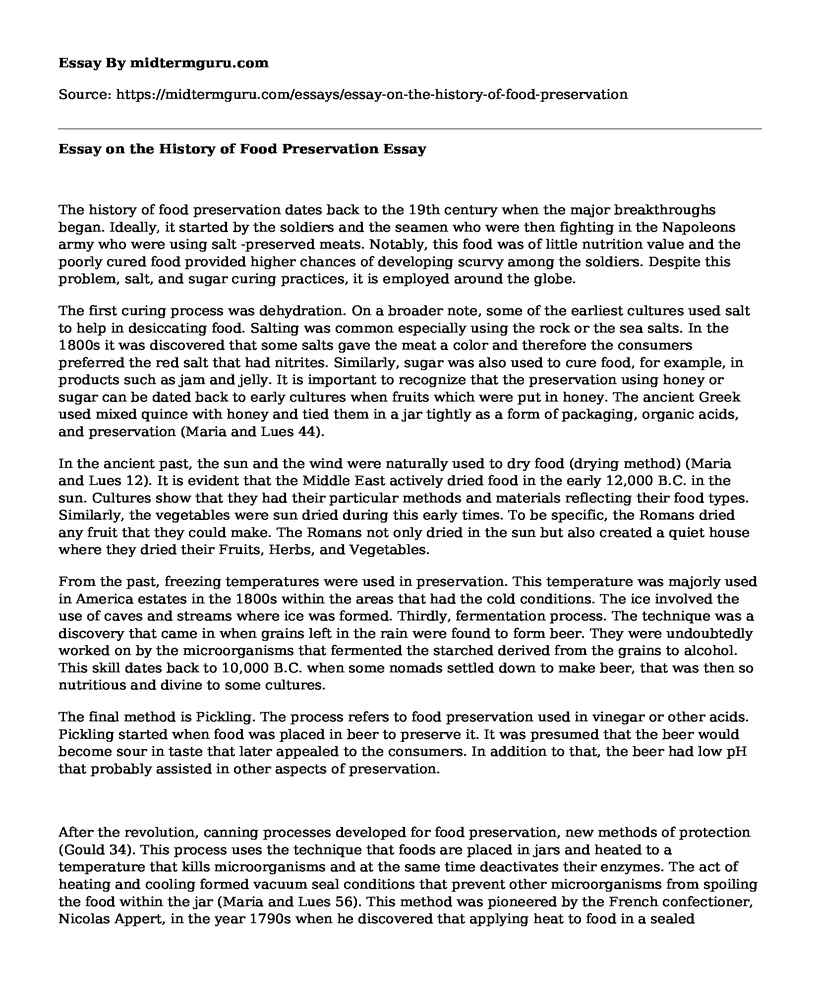The history of food preservation dates back to the 19th century when the major breakthroughs began. Ideally, it started by the soldiers and the seamen who were then fighting in the Napoleons army who were using salt -preserved meats. Notably, this food was of little nutrition value and the poorly cured food provided higher chances of developing scurvy among the soldiers. Despite this problem, salt, and sugar curing practices, it is employed around the globe.
The first curing process was dehydration. On a broader note, some of the earliest cultures used salt to help in desiccating food. Salting was common especially using the rock or the sea salts. In the 1800s it was discovered that some salts gave the meat a color and therefore the consumers preferred the red salt that had nitrites. Similarly, sugar was also used to cure food, for example, in products such as jam and jelly. It is important to recognize that the preservation using honey or sugar can be dated back to early cultures when fruits which were put in honey. The ancient Greek used mixed quince with honey and tied them in a jar tightly as a form of packaging, organic acids, and preservation (Maria and Lues 44).
In the ancient past, the sun and the wind were naturally used to dry food (drying method) (Maria and Lues 12). It is evident that the Middle East actively dried food in the early 12,000 B.C. in the sun. Cultures show that they had their particular methods and materials reflecting their food types. Similarly, the vegetables were sun dried during this early times. To be specific, the Romans dried any fruit that they could make. The Romans not only dried in the sun but also created a quiet house where they dried their Fruits, Herbs, and Vegetables.
From the past, freezing temperatures were used in preservation. This temperature was majorly used in America estates in the 1800s within the areas that had the cold conditions. The ice involved the use of caves and streams where ice was formed. Thirdly, fermentation process. The technique was a discovery that came in when grains left in the rain were found to form beer. They were undoubtedly worked on by the microorganisms that fermented the starched derived from the grains to alcohol. This skill dates back to 10,000 B.C. when some nomads settled down to make beer, that was then so nutritious and divine to some cultures.
The final method is Pickling. The process refers to food preservation used in vinegar or other acids. Pickling started when food was placed in beer to preserve it. It was presumed that the beer would become sour in taste that later appealed to the consumers. In addition to that, the beer had low pH that probably assisted in other aspects of preservation.
After the revolution, canning processes developed for food preservation, new methods of protection (Gould 34). This process uses the technique that foods are placed in jars and heated to a temperature that kills microorganisms and at the same time deactivates their enzymes. The act of heating and cooling formed vacuum seal conditions that prevent other microorganisms from spoiling the food within the jar (Maria and Lues 56). This method was pioneered by the French confectioner, Nicolas Appert, in the year 1790s when he discovered that applying heat to food in a sealed condition would prevent it from contamination. In 1806 the principle was applied by the French Navy on some food including meat and milk. Although Appert found such an important method, he did not understand it until Louis Pasteur discovered the relationship between microorganisms and food spoilage in the 1800s.
Additionally, vegetables are now preserved through a process called blanching. The method uses steam at 180-190-degrees F to prevent bacterial growth on food. The technique is beneficial to the user since it shrinks the product hence secure packaging, it destroys bacterial enzymes and retains food colour (Maria and Lues 69). The third modern food preservation method is vacuum packaging, which uses the method of keeping food in airtight conditions and later sucking the air to deprive organisms of oxygen which they breathe and then spoils the food. The final method is the refrigeration process. This method uses the refrigeration temperatures to slow the growth of pathogenic organisms. However, the microbes are not killed therefore the food product is to be used quickly within a time frame.
In conclusion, food preservation methods have historical meanings. For example, the food was kept not only upkeep but also for ceremonies. However, interests have changed such that individuals have to preserve food because they have to do it. Otherwise, there would be a shortage amongst them due to the increasingly growing population. Scientists are coming up with different methods and appliances to be used in enhancing food security among increasing population.
Works Cited
Gould, Grahame Warwick. New methods of food preservation. Springer Science & Business Media, 2012.
"National Center for Home Food Preservation | NCHFP Publications." National Center for Home Food Preservation, nchfp.uga.edu/publications/nchfp/factsheets/food_pres_hist.html.
Theron, Maria M., and Jan Frederick Rykers Lues. Organic acids and food preservation. Taylor & Francis, 2011
Cite this page
Essay on the History of Food Preservation . (2021, Jun 03). Retrieved from https://midtermguru.com/essays/essay-on-the-history-of-food-preservation
If you are the original author of this essay and no longer wish to have it published on the midtermguru.com website, please click below to request its removal:
- Whether Vegetarianism Is Healthier Than Eating Meat - Essay Example
- Paper Example on Food Consumption Practices
- Fast Foods Are Not Worth the Risk - Essay Sample
- Case Study on Khalid's Diet
- Nutrition Science and Its Benefits: Beyond Weight Management - Essay Sample
- Diana's 12-Week Transformation: Achieving a Healthy Fitness Lifestyle - Essay Sample
- A Healthy Nation: Our Wealth and Privilege - Speech Example







